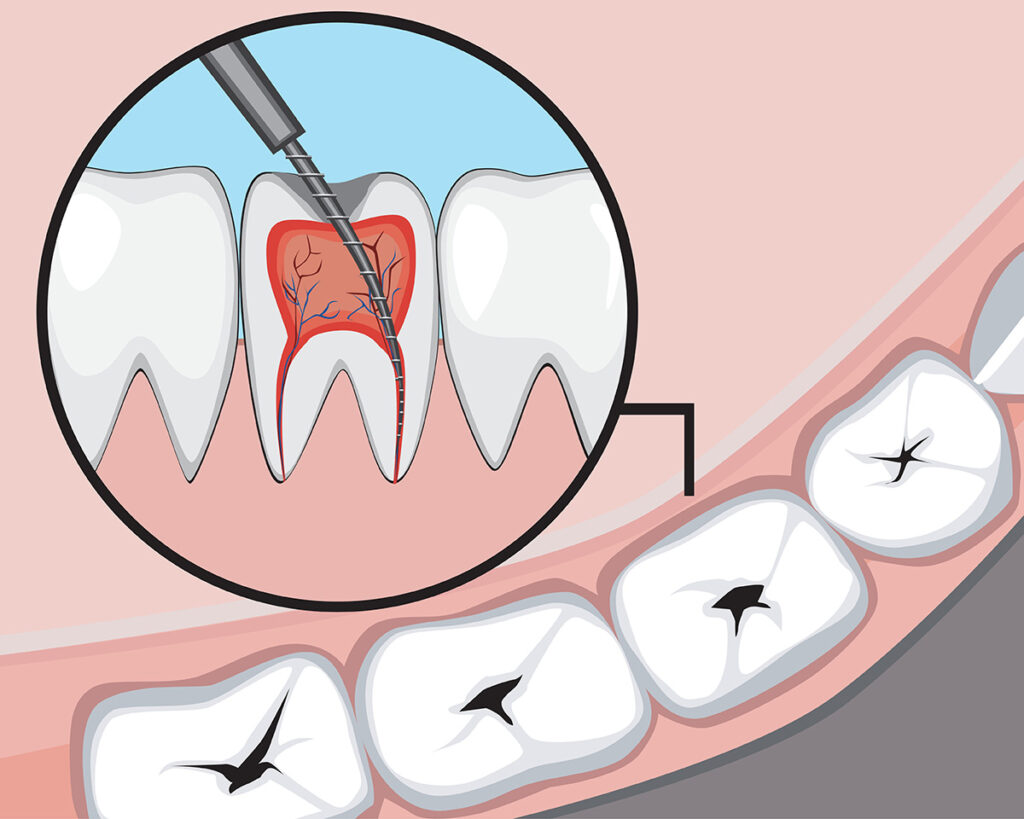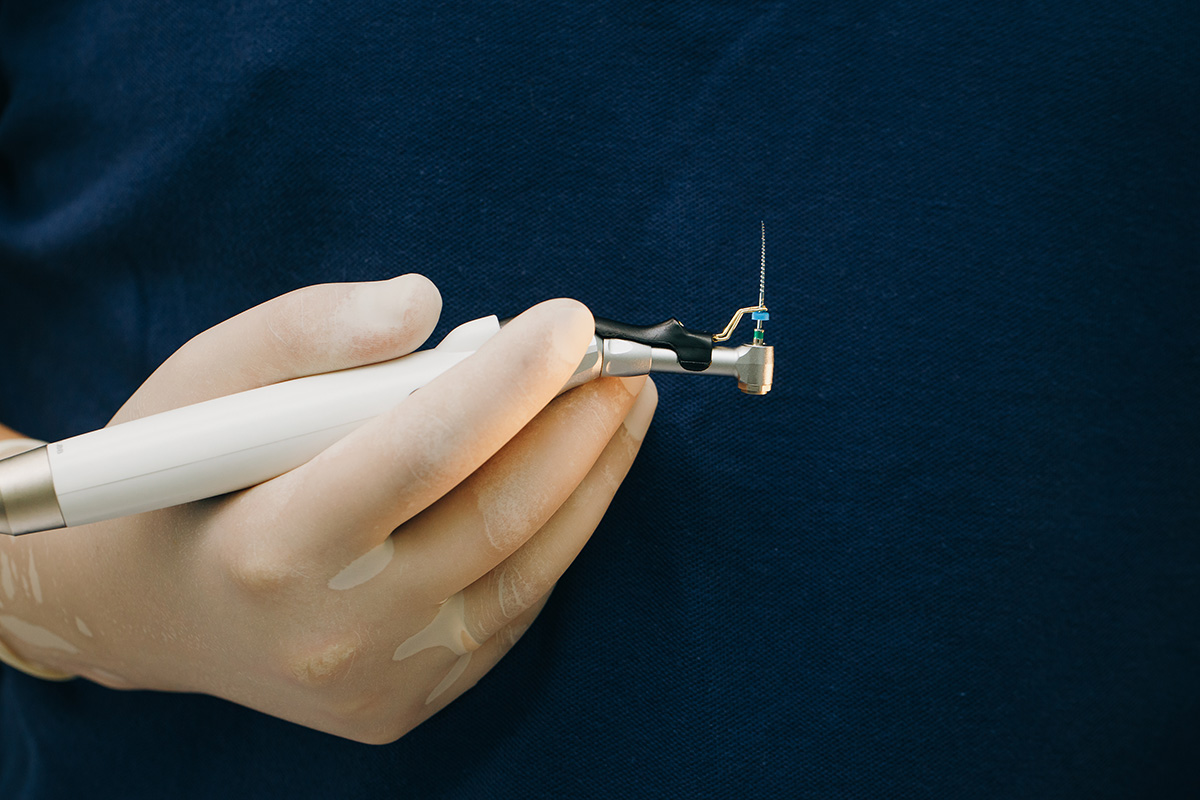Painless Dental Nerve Removal
Neglected caries or unexpected dental trauma may cause pain. At the beginning, it manifests as sensitivity to hot or cold. The pain comes when applying pressure or biting. Then it transforms into sharp or dull pain irradiating to the temple or ear and afflicting the jaw.
Structure of the Tooth
To understand how pain syndrome occurs, consider the tooth structure, which consists of several tissues:
- Hard, smooth and durable enamel;
- Dentin – a strong but porous tissue;
- Soft pulp, containing blood vessels and nerve tissue, located in the center of the crown and canals.
‘The dental nerve,’ or pulp, nurtures the dental tissues from within and contributes to their regeneration. When the integrity of enamel is damaged, bacteria penetrate deep into the dentin, pulp, and root canals, and cause an inflammatory process accompanied by pain. The least enduring patients are ready to remove the bad tooth immediately.
Arguments in Favor of Depulpation
Depulpation solves all problems, which means the dental nerve is to be removed. A tooth without pulp becomes dull and more fragile. However, it can still serve for a very long time.
Partial preservation of pulp is possible in treating deep carious cavity against minor sensitivity to temperature changes. It is often used in pediatric dentistry for the treatment of milk teeth. If periodontitis or pulpitis develops, only complete extirpation (removal) is prescribed.
The removal of the nerve is performed under general or local anesthesia so that the patient does not feel discomfort during this operation.
Many people wonder: is it painful to remove a nerve?
The nerve can also be removed with the help of the sedation with the ‘laughing gas’ of nitrous oxide, used in the Denta Vita clinic.
How Depulpation of the Tooth is Performed
Our specialists perform tooth nerve removal without arsenic in one visit with the help of a German microscope Karl Kaps. At the preparatory stage, dental tomography is done to assess the situation accurately and plan the correct treatment tactics.
Extirpation technique:
- Administering anesthesia and placing a cofferdam.
- Drilling the crown until the pulp chamber is reached.
- Nerve tissue is removed with special instruments. The operative area is periodically washed with the sodium hypochlorite solution for the pulp’s purification and complete dissolution. At the same time, the dental canals are expanded with endodontic instruments. This stage lasts for about 30-40 minutes.
- The whole process is carried out under the control of dental tomography and an apex locator. It prevents the release of the material over the root apex. Moreover, it is done to avoid the root canal being filled up to the apex!
- The final stage is drying and filling with sealing paste and gutta-percha. A permanent photopolymer seal is inserted.

Dental Nerve Removal: The Consequences
Normally, a tooth without a nerve does not hurt. If the discomfort persists after a long time, the cause is to be found in the surrounding tissues or in the poor quality of the conducted operation to remove the nerve and seal the canals.
1. A dead tooth hurts
Everyone experiences discomfort during the first 2-3 days after the procedure. It happens because, despite the nerve extraction from the dental canals, sensitive nerve endings remain in the tissues surrounding the tooth. Over time, they also lose their ability to perceive signals.
2. A tooth without a nerve hurts when pressure is applied
If the pain appears in some time after removal, it’s necessary to pay attention to the condition of the gums or maxillary sinuses. As a result of inflammation caused by sinusitis, purulent collections are formed in the sinuses, which causes pain in the upper row’s teeth.
In the case of gingivitis or periodontitis, the growing colonies of bacteria destroy the periodontal ligament. An abscess formed under the gum puts pressure on the surrounding tissues, radiating the pain to a dead tooth. Constant discomfort when biting can be caused by a dental filling that is too high, which excessively strains the ligaments that hold the tooth in the alveolus.
3. A tooth hurts in a month after the removal of the nerve
If pain disturbs in a month after extirpation, this may be due to:
- an infection in the canal that causes inflammation caused by non-hermetic filling, poor-quality rinsing or the ingress of foreign pieces of tools;
- an allergic reaction to the filling material;
- the inflammation of the dental nerve in case of its incomplete removal;
- bad adjacent tooth, in which acute inflammation occurs (it may also be similar to inflammation of the trigeminal nerve after tooth treatment).
Feeling unwell can be caused by the inflammation of the tooth’s root without a nerve. It can happen in case of perforation after an unqualified treatment.
This situation can be accompanied by increased body temperature and swelling of the adjacent cheek or gum. To stop an abscess, it is best not to delay, but visit the clinic urgently.
Painless dental nerve removal is real in the setting of the Denta Vita clinic. The best specialists who can carefully and skillfully solve any problem are at your service. Advanced techniques and modern equipment and the knowledge and experience of our professionals guarantee quality dental treatment without pain and discomfort.
